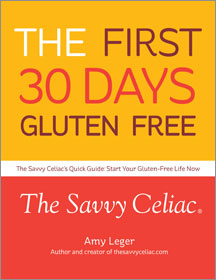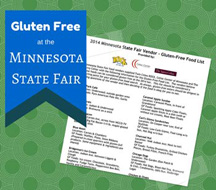Sorry about my lack of blogging in the last week. My other grandmother died and I was spending some quality time with family. While it was a bit of an emotional roller coaster, during some conversation I received a good blog topic idea which I thought I would tell you about. My brother who has celiac recently began complaining to my sister-in-law that he was “getting something” somehow. He could just feel it. And the mystery ensued….
Not knowing what it was they continued life as normal, then one day he went into the bathroom to touch up sanding some of his drywall – with no mask. And he got very sick – yes a gluten reaction. Turns out he’d been wearing a mask while doing this sanding, but it was enough to make him feel like he was “getting something”. Once the mask was off—it was a downright glutenization!
So I began researching the subject—and there is very little information out there about this to be honest. I did find a similar example on the Gluten Free and Beyond Forum
One contributor talked about the drywall-gluten link:
“I didn’t know this and had the worst time breathing and a “gluten ‘ reaction last fall when we had our kitchen work done. I was thinking we’d have some work done this fall, but it would involve drywall again. Is there a gluten free drywall brand that you can recommend? Now doesn’t that sound like a totally gluten paranoid question? But it is, our reality.”
So is gluten in drywall?
What’s in it? I was able to find some information…
“…raw gypsum is mixed with several additives, including starch, paper pulp and an emulsifier (or thickening agent), then blended with water to form a thick paste.” – Howstuffworks.com
There is no detail on what kind of starch is involved here or what the “thickening agent” is. One possible alternative to traditional drywall that I found was quickly shattered as well. It is an environmentally-friendlier version called Enviro Board. I found it likely won’t help celiacs with this dilemma.
“Enviro Board is the product of a unique, patented technology which converts agricultural waste, typically in the form of rice or wheat straw, into a low-cost, high specification building panel suitable for a wide variety of construction and other purposes.” Enviroboard.com
Most of the answers are vague at best. But when celiacs complain that they are getting sick from drywall dust—there must be something in there that’s causing a gluten reaction. This it tough news to hear when you have celiac disease and you have a bathroom or kitchen remodel lined up and ready to go.
Celiac-friendly solutions
Well a simple solution is to just get out of the house during the construction. But often that won’t work, plus you still have to clean up any dust residue.
The United States Centers for Disease Control recommends vacuum sanding during the drywall process. Its recommendation doesn’t come from gluten contamination but rather for lung health. But there’s no reason why this shouldn’t be useful for someone with celiac disease.
We were busy finishing our basement when Emma was about one year into her celiac diagnosis. But we were lucky the work was contained to the basement. She had no reason to even need to be downstairs for anything. So when my husband worked on sanding he put a damp towel at the base of the door from the basement to the rest of the house. For us it seemed to really help. We had no trouble with Emma getting sick from our construction project.
Good luck with your project, and feel free to pass along other construction recommendations in the comment area below!
Tags: celiac, construction, drywall, dust, gluten



Leave a Reply